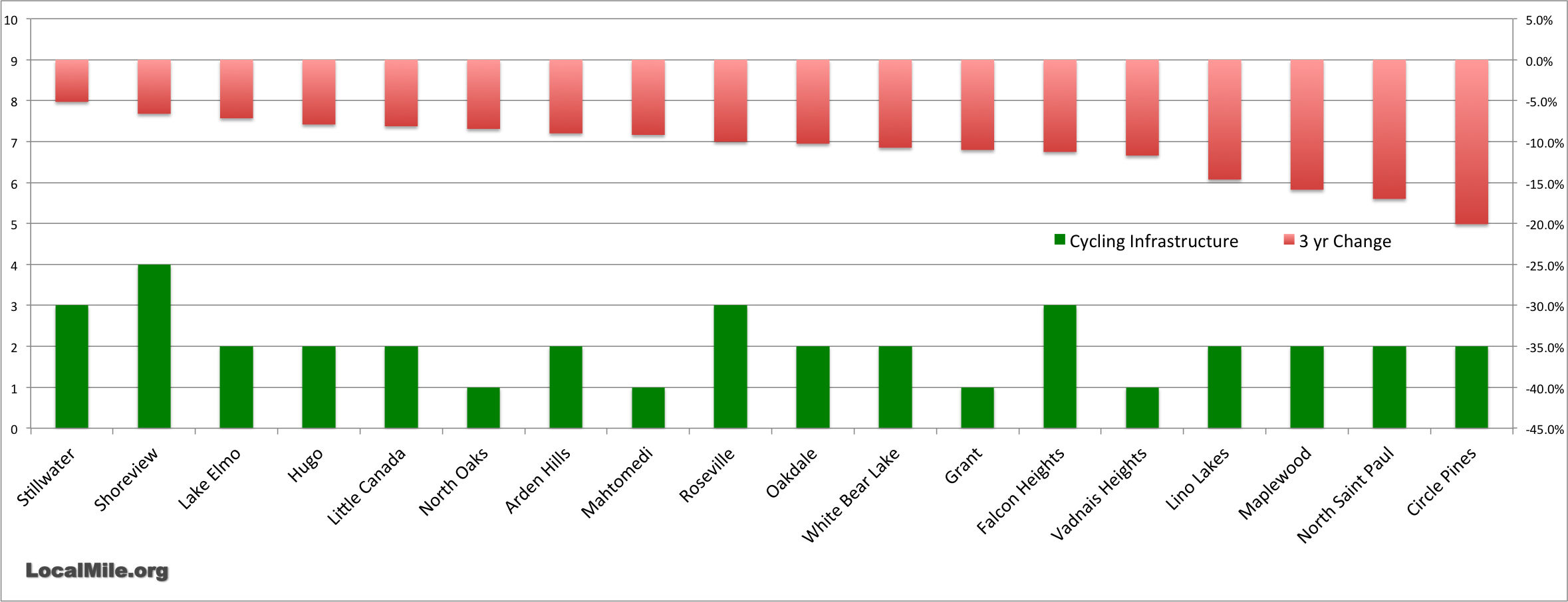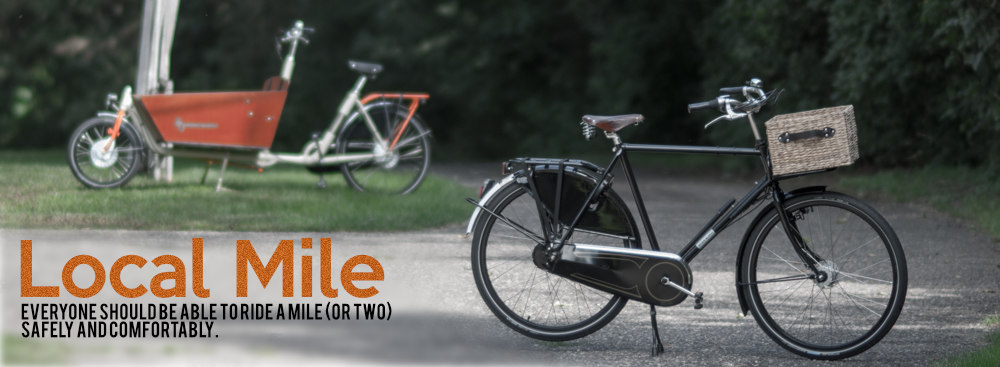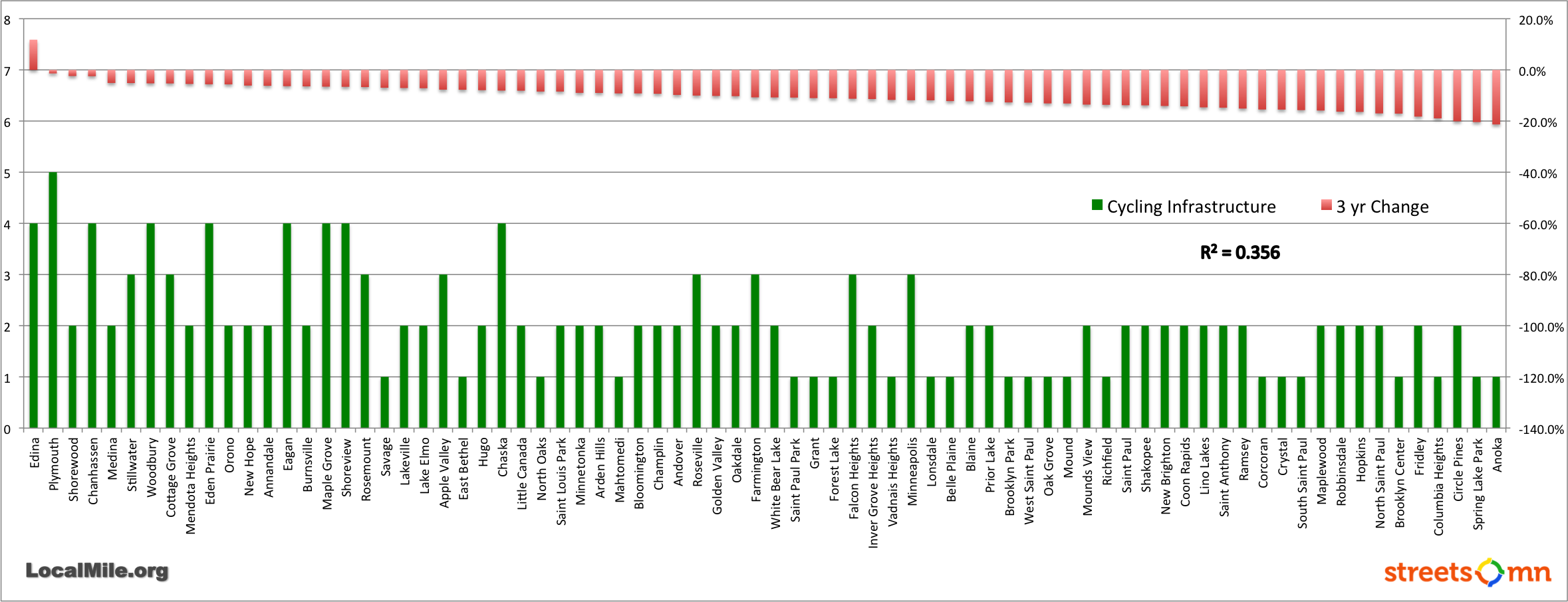Some time ago I did an analysis of how well home values were recovering in various Twin Cities communities. The lack of new construction caused by the recession gave us a very unique opportunity to see how house buyers value communities—somewhat apart from the houses themselves. In other words, what really is the value of location, location, location.
We looked at the correlation between a number of factors and how well cities did with value retention and recovery. Some of these factors were crime (high correlation), proximity to local grocery, pharmacy, and eating (high), the presence of retirement communities (moderate), parks (moderate), and sports facilities (low).
Of particular interest was that there appeared no correlation between overall per capita housing value and how well cities performed through the recession. Wealthy and less wealthy were equally spread out among winners and losers. North Oaks for example has the second highest per capita housing value in the metro yet ranked 28th in value retention over our 3 yr study period[1].
At the same time I was working on another project to rate local pedestrian and bicycling facilities and friendliness—the ability of residents and workers to safely and comfortably walk or bike to local destinations like schools, churches, eateries, and grocery stores.
Out of curiosity I married these two projects a bit to see how pedestrian and bicycling infrastructure might impact house values and was quite surprised at how high of a correlation there appeared to be[2].
The red bars on the chart below (scale on the right) show the change in home values for each of the 76 cities in the Twin Cities Metropolitan Area over the three year study period (thru November 2012) —approximately 31 months of market decline and 5 of recovery[3].
From a monetary standpoint most of us would prefer to be in one of the communities towards the left that did relatively well during the recession rather than one towards the right. Houses in Anoka lost 22% of their value on average. That hurts. (Click for larger image)
The green bars indicate the relative cycling and pedestrian infrastructure in each of these cities. For reference, Amsterdam might be about a 20 on this scale, Copenhagen 15, and Stockholm 10. So, though 5 seems good, even our best lags well behind much of the developed world. This is similar to our roads being considerably more dangerous. A child riding in a car here is about three times as likely to be killed as one in The Netherlands.
Notice where the cities with better cycling infrastructure land on the chart and how this correlates to how well they did coming out of the recession. All of the suburbs with a cycling infrastructure rating of 4 or 5 are in the top third of housing value retention, and all but one rated a 3 are in the top 50%.
More importantly, looking at the three year change in value based on cycling infrastructure, those with a rating of 5 lost 1.4%, 4’s lost an average of 3.6%, 3’s lost 7.9%, 2’s lost 11%, and 1’s lost 13.2%.
Also note that the presence of cycling infrastructure is not very dependent on the overall value of housing in a city. Plymouth is 13th in overall house value with an average less than half that of top ranked Orono yet has excellent bicycling infrastructure and is 2nd best in value retention. Eagan, Maple Grove, and Chaska are right near the middle of the 76 metro cities in overall per capita housing value yet have fairly good walking and bicycling infrastructure and have done much better than average in value retention.
Walking and bicycling infrastructure also appear to have had a greater impact on house values than factors such as schools, and distance from the core downtowns of Minneapolis and St Paul, or the presence of lakes, sports, or senior living facilities. Only crime and proximity to shopping and eating appear to be valued more by buyers.
In the end I’m not sure to what extent the facilities themselves may impact how someone values a city versus secondary impacts like more people being active in a neighborhood make it more appealing. In other words, how many people specifically want the bikeways and how many see a bunch of folks out and about and like that.
Northeast Metro
Now, let’s look closer at our own backyard.
 There is still correlation with our 18 northeast metro cities but noticeably less than in the entire metro. This is not surprising given the much smaller sample size.
There is still correlation with our 18 northeast metro cities but noticeably less than in the entire metro. This is not surprising given the much smaller sample size.
Cities ranked 1 lost 10.1% of their value, but those ranked 2 lost 12.1%. The three cities ranked 3 lost 8.8%, and our lone 4 lost only 6.6%.
Clearly, buyers value NE Metro cities with bicycle and pedestrian facilities ranked 3 or 4 much higher than those ranked only 1 or 2 though the differences are not as stark as metro wide. Again, how much bicycle and pedestrian infrastructure actually plays in to this is difficult to say. Perhaps a major element is that the cities who value safe bicycle and pedestrian facilities also value other things that buyers value—kind of a package deal.
What Creates Value?
There are many factors that influence how someone values a city and what impact that has on their desire to live there and to pay a value premium for doing so. It is all of the things that bundle up to become location, location, location.
Nationally there are three factors that have emerged quite strongly over the past 10 years across all buyers though particularly among younger buyers; community, walkability, and quality.
Quality refers to people’s increasing desires for quality and longevity of design and construction in their own home and of those in their neighborhood.
Walkability is people’s desire to scale back their dependence on automobiles and the amount of time they spend in them. They want to be able to walk or ride a bicycle to schools, eateries, and for local errands such as groceries[4]. Some also want good transit options for somewhat longer journeys such as trips to downtown or sporting events.
This is particularly strong among Millennials who are driving less than prior generations. There are a number of reasons for this but improved health, lifestyle, and enjoyment appear the primary elements.
Note that WalkScore is a very poor indicator of reality. WalkScore is based purely on distance with no regard to quality. It will rank a 0.5 mile walk/ride on a 45 MPH road with no shoulders or sidewalks much higher than a 1 mile walk/ride along a 35 MPH road with 10′ wide shared use paths on each side. In reality the former, like Vadnais Heights, will have nobody walking and the latter, like Shoreview, will have a gob of people walking and bicycling.
Third is Community. People want to live where neighbors know each other. Where they see each other at and going to the local grocery (or Village Scoop or Ingredients) and not a million people they don’t know. They want to shop and eat where they see the owner in person, not just on the cover of Fortune magazine[5]. And, they want to put down roots. They want to be somewhere that they feel they’ll be happy for 70 years, not just 7[6].
There is a fourth factor sometimes mentioned and that is a desire for better quality, healthier, and local food options. This includes both shopping and dining[7]. The local part is both the source of the food and of the owner, large franchises need not apply.
These are all also critical in why younger generations have been increasingly opting for urban rather than suburban living, even after they have children. Locally this is one reason why St Paul and Minneapolis have held their values so unusually well against suburbs.
This isn’t new but simply getting back to the way we did things for hundreds or thousands of years before the ascension of suburbs in the 1950’s. Historically we’ve built communities around a central village of daily necessities. We wanted to be close to a grocery, general stores, pubs, and schools so these were at the center with everyone living among and around them. The benefits of cars changed this with the suburban model separating what had been closer and mixed together. With typical suburban development people live in a large housing zone, drive to another zone for shopping, and to another for work. In 1950 this looked glamorous but today we’ve learned that spending a lot of time in our cars and traffic isn’t so much fun. What we are seeing today is a desire to get back to being close to daily amenities and to having the smaller tighter identifiable communities that we had prior to the rise of suburbs.
We’re Careful About What We Can’t Control
Something that became apparent in this study is that buyers increasingly place greater emphasis on fixed externalities than on things they have some personal control over. A kitchen, yard, or entire house can be remodeled and children can go to other schools but the freeway next door or view of an industrial plant likely won’t be changing.
For suburban house shoppers some fixed externalities often mentioned include traffic, crime, noise, pollution, and nearby properties that are poorly maintained. On the flip side, proximity to local shopping (grocery, pharmacy, etc) and eateries is increasingly critical.
Rail, both commuter and tram, is beginning to bubble up a bit as well. Both for being a desirable alternative to driving or riding a bus and because it reduces traffic (and thus noise, pollution, number of lanes required, etc.) on all roads and particularly on higher speed and volume roads.
People out eating, walking, playing, running, and riding bicycles adds to appeal. One realtor said that there’s nothing that sells Shoreview like a potential buyer seeing a bunch of people riding bicycles to Dairy Queen.
Local churches in a community add appeal though mega churches and their traffic not so much.
How Un-Valuable is Value?
A final thought. There is little to no correlation between home value and happiness. Numerous studies have found that nationally about $70k in household income is peak happiness value. Earning more doesn’t bring any greater happiness.
I know one family who sold a nearly $1 million suburban house and moved in to a smaller house about 1/3 the price in Cathedral Hill. After five years they say they are happier, enjoy being closer to neighbors, knowing their neighbors better, and walking or riding bicycles to shop and eat. This move wasn’t a financial decision but primarily to reduce the amount of time they spent driving. They said they got an unexpected bonus in no longer needing both of their cars and the lower financial burden has meant less stress and greater happiness.
I know one family (and possibly another now that I think about it) who moved closer to downtown White Bear Lake for similar reasons. Less house but closer to places to shop and eat. I know another who chose Circle Pines because they can ride dirt bikes there.
Despite the title, this isn’t really about monetary value so much as what people want in their communities. Monetary value is simply a proxy for a-lot-of-people-desire-this.
[1] North Oaks sank to 53rd in the following months. This most recent sinking however was likely due primarily to increased sales of new construction that has values below North Oaks average.
[2] Note that the pedestrian and bicycle ratings are highly subjective and based on opinions of a number of individuals. While they are likely fairly accurate they are not completely objective and did not include significant in-depth analysis of every city. Many are also borderline. While Shoreview is a 4, it could just as well have been a 5. Likewise, Maple Grove is a 4 but should perhaps have been a 3.
[3] These were calculated using 6 month running averages so should be fairly representative of actual. The period was chosen based on housing start data and ended when construction activity picked up. Normally new construction drives the average housing values in a city more than anything so this period gave us a very unique chance to see values without them being hidden by new construction.
[4] Note that walkscore and bikescore have proven poor measures as they are focused on distance and not quality. A half mile walk along a busy road with no sidewalk is rated better than a three-quarter mile walk along an appealing segregated path.
[5] One couple told me that one reason they like living in downtown St Paul is that they don’t want to be tempted by Costco. They like shopping at relatively local stores (Lunds and Mississippi Market) and going to local eateries (Nina’s and Cheeky Monkey).
[6] Somewhat related to this people want a strong city (finances, planning, community involvement, etc). They don’t want to live in a city that they expect will encounter difficulties in future years taking care of local roads, parks, and other amenities.
[7] A study by Zillow indicated that being near a Starbucks had a noticeably positive impact on house values. Given that Starbucks are usually co-located with other eateries this could well have been simply an indicator that people want to live near eateries not necessarily Starbucks.

